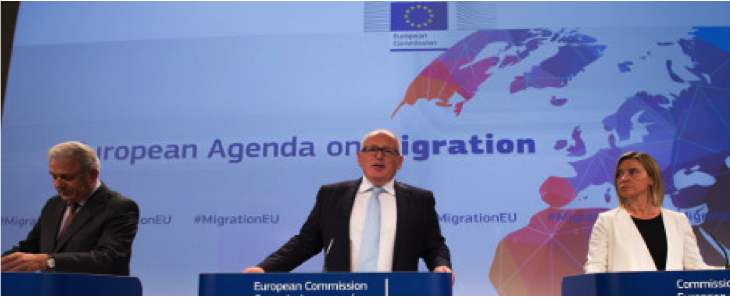On Wednesday, 13 May, the European Commission unveiled its highly anticipated plan to deal with the increasing number of migrants trying to reach European shores. The long-awaited European Agenda on Migration made waves in the media with its system of immigration quotas and proposal for military action in the Mediterranean.
The “immediate action” called for by the Commission establishes a set of measures to deter and dismantle traffickers’ networks, while also distributing the burden of resettling asylum seekers amongst EU member states. The Commission’s proposal to mount an operation against “smugglers’ assets and vessels before their use” caught everyone’s attention. It will be elaborated further but already the question is raised whether, in addition to naval patrols, “boots on the ground” will be deployed on the Libyan coast as a result.
Any such use of military force abroad needs to be authorized by the United Nations Security Council. The address to the Council by High Representative Mogherini on 11 May 2015 was meant to prepare the ground for that. A draft resolution is reportedly being prepared by the EU member states serving on the Council, including permanent members UK and France, and non-permanent members Lithuania and Spain. If this goes ahead, the European Union will need to wrestle with a very volatile situation in Libya, where local militias and rival governments have to be factored in as threats to the success of the operation and the safety of EU military personnel.
Another point on the Commission’s Agenda is an “emergency mechanism”, which will help relocate asylum seekers in EU member states based on the GDP, unemployment rate and population size of each state. The Commission calculated that the lion’s share should go to Germany with 18.4% of asylum seekers, followed by France with 14.17%, Italy with 11.8% and Spain with 9%. The goal is to have more of the member states sharing the burden. Currently, the system is particularly detrimental to the country where the asylum seeker enters the EU and the few preferred destination countries.
Another recommendation coming from the Commission is the call to set up an “EU-wide resettlement scheme” for 20.000 refugees in 2015-2016. The plan will have to cover every member state and will cost roughly €50 million. The UK, Denmark and Ireland are allowed, under EU law, to ask for an exemption from the quota plan. Refugees will be distributed amongst member countries using the same quota system as for the asylum seekers, with Germany again taking in the greatest number. The plan hasn’t been short on criticism, with the UK Home Secretary saying that this would encourage even more people to make the dangerous journey across the Mediterranean in the hope of reaching Europe.
Recognizing Europe’s demographic decline, and the need to remain an attractive destination for migrants, the Commission proposed the review and modernization of the Blue Card scheme that offers an avenue for legal migration. More details on this and other proposals will continue to be presented, while the package will be discussed by the EU leaders at the upcoming European Council meeting in June. Nothing has been finally resolved but there is certainly a lot on the table and some positive measures are being taken on the ground, even if on a provisional basis for now.


